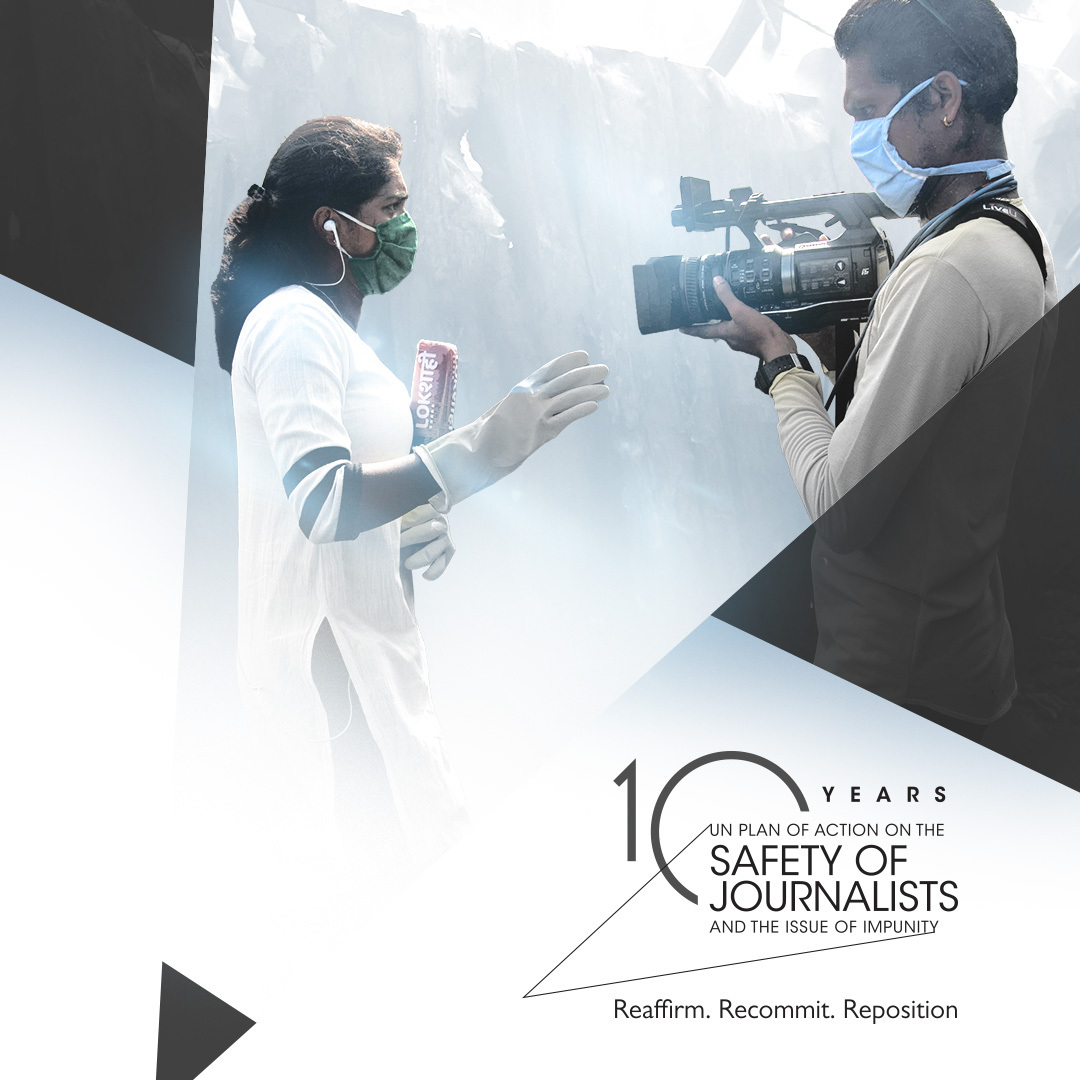Journalism – an essential but dangerous profession
Journalism is fundamental for sustainable development, human rights protection and democratic consolidation, but remains a dangerous and too often deadly profession - and nine times out of ten, the murder of a journalist is unresolved.
According to the United Nations Educational, Scientific and Cultural Organization’s UNESCO Observatory of Killed Journalists, more than 1,600 journalists have been killed since 1993.
Other threats against journalists, online and off-line, continue to grow, especially in non-conflict zones. Journalist imprisonment is at a record high, while online violence - particularly against women journalists - and harassment spurs on self-censorship and, in some cases, physical attacks.
Journalists have also increasingly been attacked while covering protests, by various actors, including both security forces and protest participants.
Numerous reports and studies confirm that threats inordinately affect women journalists and those who represent minority groups.
“Stop targeting truth and truth-tellers.
As journalists stand up for truth, the world stands with them.ANTÓNIO GUTERRES, United Nations Secretary-General

UN Plan of Action on the Safety of Journalists and the Issue of Impunity
Aiming to create a free and safe environment for journalists and media workers, in 2012, the United Nations developed in a participative and multi-stakeholder manner the first-ever systematic global strategy to protect journalists, which brings together UN bodies, national authorities, media, and civil society organizations. The UN Plan of Action on the Safety of Journalists and the Issue of Impunity addresses the fundamental aspects of prevention, protection, and prosecution.
The Plan was the result of a process that began in 2010 upon the request of UNESCO’s Intergovernmental Programme for the Development of Communication (IPDC). It was then endorsed by the Chief Executive Board of the United Nations and launched in Vienna at the 2nd UN Inter-Agency Meeting on the Safety of Journalists in November 2012.
The Plan calls for a coalition-based and holistic approach to its implementation, which is coordinated by UNESCO, as the UN specialized agency in the field of the promotion of free flow of information. It includes six areas: raising awareness; standard setting and policy making; monitoring and reporting; capacity-building and research. Thousands of activities at the global and country level have taken place to implement this Plan, as reflected in the dedicated newsletters.
The Plan's 10th Anniversary
The 10-year anniversary was a milestone to Reaffirm, Recommit and Reposition efforts to advance the UN Plan.
- Reaffirm the relevance of the UN Plan of Action as the blueprint of all parties involved tasked with protecting the safety of journalists.
- Recommit political will, purpose, and resources to advance the Plan’s objectives.
- Reposition to increase impact on the ground, prevent attacks, protect journalists in danger and hold those accountable that are responsible for attacks against journalists.
The 10th anniversary has been an opportunity to take stock of its key achievements during this first decade of implementation, as well as to identify solutions to challenges that have arisen along the way. In this respect, UNESCO coordinated a multi-stakeholder consultative process involving regional and thematic consultations to collect partners’ experiences in promoting safety of journalists.
The process culminated in November 2022, when representatives of governments, civil society and international organizations gathered at a high-level conference marking the 10th Anniversary of the Plan in Vienna, Austria. Over 50 countries renewed their commitment to the UN Plan of Action by a political declaration complemented by pledges, as well as civil society’s Call to Action.
They committed to addressing new and emerging threats to the safety of journalists, media freedom and media pluralism, such as those arising in the digital age, as well as the specific risks faced by women journalists in relation to their work.

Read the Outcomes of the regional and thematic consultations to mark the 10th anniversary of the UN Plan of Action on the Safety of Journalists and the Issue of Impunity.
Impact of the UN Plan of Action in the Last 10 Years
Prevention
- 1,300 advocacy events organized on the safety of journalists since 2012
- 6 Global Campaigns on the occasion of the International Day to End Impunity for Crimes against Journalists
- An SDG indicator (16.10.1) in Agenda 2030 on the safety of journalists
Protection
- Creation of the UNESCO Observatory on Killed Journalists
- At least 50 National Protection Mechanisms for the safety of journalists established since 2012
- Two regional digital platforms in Europe and Africa to monitor attacks against journalists and over half a dozen of national ones
Prosecution
- Impunity rate down by 9 percentage points from 95% to 86% in ten years
- More than 30,000 judicial operators from 150 countries and more than 11,500 security forces from 160 countries trained on safety of journalists and freedom of expression
- 500 lawyers trained in 30 countries and 1,000 cases of legal assistance provided to journalists in distress over 2020 and 2021, funded by the support of the Global Media Defense Fund
The UN Plan in the next 10 years and beyond
The first ten years of the UN Plan of Action on the Safety of Journalists and the Issue of Impunity have seen significant improvements in promoting a safer and enabling environment for journalists and media workers, despite shrinking press freedom, reduced public trust in professional journalism and the disruption of media business models.
But the past ten years have also seen setbacks and the emergence of new threats to the freedom of expression and the safety of journalists, which were not anticipated when the Plan was first conceived.
Among these are digital challenges such as digital surveillance, online violence and cyber-crimes, particularly affecting women journalists, the increasing prevalence of disinformation and hate speech and the exponential growth of digital technologies giving rise to concerns about the misuse of digital platforms and the role of internet companies in mediating freedom of expression and the safety of journalists.
These challenges further include the use of strategic lawsuits against public participation (SLAPPs), which are often aimed at journalists to prevent them from reporting on matters of public interest or the increasing need to provide emergency assistance to journalists in both conflict and non-conflict settings. During the Universal Periodic Review under the Human Rights Council, UN Member States are evaluated on their performance on freedom of expression and the safety of journalists and have recently been provided with tools on best practices in that regard.
Strengthening the implementation of the Plan in the next decade, therefore, requires addressing these emerging challenges.
The United Nations - Committed to protecting journalists
The UN is actively working to protect journalists. This is evidenced by an increasing number of declarations, resolutions and other normative texts, the UN Secretary-General’s latest report on the safety of journalists and impunity, and his Call to Action for Human Rights. Protecting journalists is also part of the 2030 Agenda for Sustainable Development.
The Office of the UN High Commissioner for Human Rights (OHCHR) is mandated to promote and protect the effective enjoyment by all of all human rights, including the rights of journalists and media workers. OHCHR works to implement General Assembly and Human Rights Council mandates on the safety of journalists. The Special Rapporteur on the promotion and protection of the right to freedom of opinion and expression is also advocate for the safety of journalists.
As the UN agency with a specific mandate to promote “the free flow of ideas by word and image,” UNESCO works to promote the safety of journalists and combat impunity for those who attack them. This includes the training of judicial actors and security forces on international standards in freedom of expression, access to information and the safety of journalists.
One of the main goals of the UN Plan of Action is to raise awareness on the importance of independent and professional journalism. International Days, such as World Press Freedom Day (3 May) and the International Day to End Impunity for Crimes against Journalists (2 November) encourage discussion and analysis and promote initiatives related to freedom of press, the safety of journalists and the issue of impunity.
